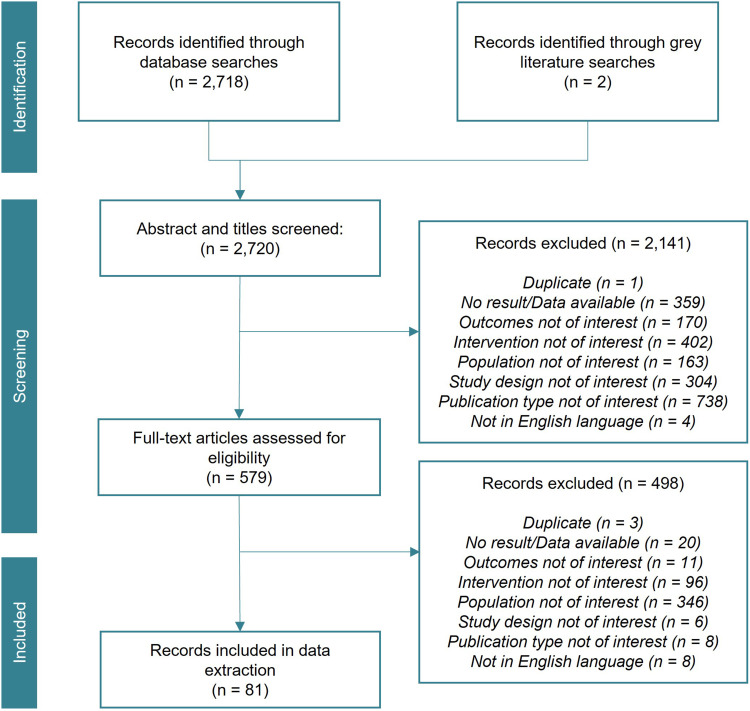Abstract
Introduction
Selective laser trabeculoplasty (SLT) and minimally invasive glaucoma surgery (MIGS) are increasingly used options for mild-to-moderate open-angle glaucoma (OAG) care. While most MIGS devices are indicated for use in combination with cataract surgery only, with phacoemulsification playing a role in lowering IOP, newer technologies can also be used as standalone glaucoma surgery.
Methods
This systematic literature review (SLR) aimed to assess the clinical, economic, and humanistic outcomes of MIGS and SLT for the treatment of OAG and was conducted according to PRISMA guidelines. Studies that assessed MIGS or SLT in at least one treatment arm versus any other glaucoma treatment in adults with mild-to-moderate OAG were included. Clinical, humanistic (health-related quality of life [HRQoL] and patient burden), and economic data were extracted, and the methodological quality of included studies was evaluated.
Results
A total of 2720 articles were screened, and 81 publications were included. Fifty-eight reported clinical outcomes. The majority assessed iStent or iStent inject (n=41), followed by OMNI (n=9), gonioscopy-assisted transluminal trabeculotomy (GATT) or the Kahook Dual Blade (KDB) (n=7), Hydrus (n=6), SLT (n=5), Xen Gel Stent (n=2), PreserFlo (n=1), and iTrack (n=1). IOP reduction was observed across prospective studies, varying from −31% to −13.7% at month 6 and from −39% to −11.4% at year 1 versus baseline. Most adverse events were transient and non-serious. Limited humanistic and economic data were identified.
Conclusion
Given their established efficacy and safety, there is a rationale for wider use of MIGS in mild-to-moderate OAG. Of the MIGS devices, iStent and OMNI have the largest clinical evidence base supporting their sustained effectiveness.
Keywords: intraocular pressure, IOP, iStent, MIGS, OMNI, SLT
Introduction
Primary open-angle glaucoma (OAG) is a progressive ophthalmic disease that is associated with elevated intraocular pressure (IOP) resulting in damage to the optic nerve causing reduced visual fields and potentially leading to irreversible blindness.1
Maintaining IOP below 18 mmHg can slow the progression of disease and preserve the visual field in most patients.2 First-line treatment of OAG usually comprises topical IOP-lowering medications that can delay the onset or reduce the risk of progression of OAG in patients with elevated IOP.3 However, patient adherence and local adverse effects (AEs) to topical medications can be problematic.3 If topical IOP-lowering medications are contraindicated (due to their medical history or local or systemic side effects), or if medication does not sufficiently reduce IOP, laser therapy (eg selective laser trabeculoplasty [SLT]) and surgical procedures (conventional surgery or minimally invasive glaucoma surgery [MIGS]) may be used.3 In the UK, NICE guidelines recommend offering SLT as primary therapy for OAG.4 SLT lowers IOP by inducing biological changes in the trabecular meshwork (TM), resulting in increased aqueous outflow.3 In the context of randomized controlled trials, it has been shown that, after 3 years from treatment, 74% of patients randomized to initial SLT remained within target without medication and 95% reached their target IOP,5 although this might not apply to non-Caucasian patients (eg of African descent) that often present more advanced glaucoma. In terms of surgical interventions, trabeculectomy is historically the most common conventional procedure. Trabeculectomy lowers IOP by creating a fistula between the anterior chamber and the subconjunctival space to provide a lower resistance drainage route for aqueous humor.3 While it is effective in reducing IOP, trabeculectomy carries a risk of potential complications.6 Further, antiscarring agents are often applied to the surgical site to decrease the fibroproliferative response and increase success rates of surgery, but these may increase the rate of AEs, such as infection and hypotony-related complications.3
In recent years, innovative technologies have revolutionized the surgical management of glaucoma,6 with iStent being the first ab interno MIGS device approved by the FDA in 2012.7 MIGS is a term applied to a wide range of devices (implants and implant-free) and techniques that aim to lower IOP with less invasive means than the more traditional procedures of trabeculectomy, non-penetrating procedures, and tube drainage devices. MIGS procedures are considered safer than conventional surgery, such as trabeculectomy and tube-shunt implantation.8 Currently available MIGS include iStent inject, OMNI, Xen Gel Stent, PreserFlo MicroShunt, iTrack, Hydrus, GATT, and KDB. Most MIGS procedures use an ab interno clear corneal approach, cause minimal tissue damage, and have a quicker visual recovery time compared to conventional surgery.8 Both conventional surgery and MIGS facilitate the outflow of aqueous humor from the eye to bypass the impaired TM.6 Traditional surgery and some MIGS (eg Xen and PreserFlo) rely on subconjunctival filtration and require bleb formation. Due to the more invasive process, the classification of bleb-forming devices as MIGS remains controversial.9 Alternatively, most MIGS deliver the aqueous humor directly to Schlemm’s canal where it flows through the post-TM distal outflow channels.8 MIGS procedures vary in terms of their attributes, surgical complexity, comprehensiveness, efficacy, and safety. The majority of MIGS devices are indicated for use in combination with cataract surgery, while newer technologies including the OMNI Surgical System and iTrack are indicated both as standalone glaucoma surgery or in combination with cataract surgery, although examples of standalone use of other devices (eg KDB, Sinskey hook goniotomy, or bent 23-gauge cystotome goniotomy) have been reported in the literature.10
Previous systematic literature reviews have analyzed the evidence supporting MIGS and SLT for the treatment of OAG; however, more recent studies on new devices have been widely published, and therefore, there is a need to systematically summarize and update knowledge. This paper shares the findings from a systematic review of the clinical, humanistic, and economic outcomes associated with MIGS and SLT for the treatment of patients with mild-to-moderate OAG.
Material and Methods
Search Methods
The SLR was conducted and reported in accordance with the Preferred Reporting Items for Systematic Reviews and Meta-Analyses (PRISMA) guidelines and the review protocol was registered with PROSPERO (reference CRD42022300015). Searches were conducted in MEDLINE® (via PubMed.com), Embase® (via Embase.com), Cochrane Database of Systematic Reviews & Cochrane Controlled Register of Trials (via Cochrane Library), and ClinicalTrials.gov. The search was performed on 28 October 2021, and additional sources were incorporated up to January 2022, before the start of data extraction.
Eligibility Criteria
Studies were included based on PICOS-T criteria. Specifically, adults (at least 18 years old) with mild-to-moderate OAG and an intervention of MIGS or SLT in at least one treatment arm versus any other glaucoma treatment were considered. SLT was evaluated alongside MIGS, which are increasingly used earlier in the treatment paradigm of mild-to-moderate OAG, providing an alternative as a second-line treatment after IOP lowering medications. Articles published in English between 2011 and 2021 were included using specific search terms for each database, as detailed in Tables S1-S6. Grey literature searches retrieved additional two articles which were then included in the records to ensure a comprehensive review of available data. Studies conducted in the following geographical locations were of interest: Australia, Brazil, Canada, China, France, Germany, Italy, Japan, Mexico, Poland, South Korea, Spain, Switzerland, the UK, and the USA. For clinical outcomes, randomized clinical trials (RCTs) observational studies, real-world evidence or other non-RCTs were included. All studies reporting health-related quality of life (HRQoL), patient burden, and economic outcomes in the population of interest were also included. Editorials, commentaries, case reports, and narrative reviews and studies with less than 15 patients were excluded. This sample size cut-off (n=15) was chosen to balance a large enough patient population to reduce the bias and variability that can be associated with smaller studies, and yet to include as many studies as possible.
Study Selection
Titles and abstracts and full-text articles were reviewed by two independent reviewers according to pre-defined eligibility criteria. Discrepancies were resolved by a third reviewer.
Risk of Bias and Data Collection
Risk-of-bias (ROB) analysis assesses the quality of a study by determining whether the true effect of an intervention is reported correctly, incorrectly, or not reported, based on a checklist of criteria. All RCTs were quality assessed using the Cochrane ROB Tool v2.0. The Newcastle-Ottawa Scale was used to assess the quality of non-randomized studies, including studies of real-world evidence. The 24-item Consolidated Health Economic Evaluation Reporting Standards (CHEERS) checklist was used for cost-effectiveness and cost-utility analyses, as endorsed by the International Society for Pharmacoeconomics and Outcomes Research (ISPOR) Health Economic Evaluations Publication Guidelines Task Force. Data from the included studies and ROB were extracted into Microsoft Excel™. Relevant information was extracted by a single reviewer and validated by a second reviewer.
Outcomes
Clinical outcomes of interest included percentage and absolute mmHg IOP reduction by treatment, use of IOP-lowering medication, time to treatment failure (defined by use of further IOP-lowering treatment), use of rescue IOP-lowering medication and diurnal IOP fluctuation. Safety was assessed by the evaluation of AEs for each device or procedure. Economic outcomes of interest included the cost of glaucoma, direct medical costs (eg inpatient, outpatient, and pharmacy costs), indirect medical costs, the cost of blindness, and any caregiver costs. Humanistic outcomes included HRQoL and overall patient burden.
Results
Study Selection
In total, 2720 titles and abstracts were identified and screened. Of these, 579 full-text articles were assessed for eligibility. Following screening, 81 publications met the inclusion criteria and were extracted. After linking together publications, reviewers identified 74 primary publications from 74 distinct studies and seven secondary publications with additional data (eg shorter follow-up). To avoid duplication of data, reviewers reported studies based on their primary publications, and where appropriate, used secondary publications as additional sources. A flow diagram depicting study selection is shown in Figure 1.
Figure 1.
PRISMA flow diagram.
Notes: Flow chart of the procedure for identifying studies and the results thereof. PRISMA figure adapted from Page MJ, McKenzie JE, Bossuyt PM, Boutron I, Hoffmann TC, Mulrow CD et al. PRISMA 2020 statement: an updated guideline for reporting systematic reviews. BMJ. 2021;372:n71. doi: 10.1136/bmj.n71. Creative Commons.
Study Characteristics
All studies reported IOP-lowering interventions in patients with OAG (shown in Table 1, separated by main outcome of interest). The majority of studies on MIGS evaluated iStent or iStent inject (n=41), followed by ab-interno canaloplasty/trabeculotomy using OMNI (n=9). Other included studies assessed trabeculotomy with GATT or KDB (n=7), Hydrus (n=6), SLT (n=5), Xen Gel Stent (n=2), PreserFlo (n=1), and iTrack (n=1). A description of considered MIGS devices is provided in Table S7. The total sample size varied from 15 patients to 17,353 patients, and the most frequently reported sample size was approximately 100 patients. Some studies included both eyes of a patient, while others restricted inclusion to a single eye; the N for both patients and eyes are given (where known) in Table 1. Most studies were conducted in Europe (n=30), with the remainder conducted in North America (n=27), Australia (n=6), South America (n=4), and Asia (n=3).
Table 1.
Study Characteristics of Included Publications (n=74 Primary Publications)
| Study | Study Design | Device | Sample Size | Follow-Up Duration |
|---|---|---|---|---|
| Clinical outcomes | ||||
| Ahmed 2020a24 | RCT | Hydrus, iStent | 152 patients (152 eyes) | 12 months |
| Arriola-Villalobos 201259 | Prospective interventional case series | iStent | 19 patients | Mean (SD): 53.68 (9.26) months |
| Chansangpetch 202060 | Retrospective study | iStent | 89 patients (104 eyes) | 12 months |
| ElMallah 202061 | Retrospective study | KDB | 35 patients (42 eyes) | 12 months |
| Falkenberry 202013 | RCT | KDB, iStent | 164 patients (164 eyes) | 12 months |
| Fea 201711 | Prospective interventional case series | SLT, Hydrus | 56 patients (56 eyes) | 12 months |
| Ferguson 2016a62 | Retrospective consecutive case series | iStent | 42 eyes | 24 months |
| Ferguson 2016b63 | Retrospective consecutive case series | iStent | 350 eyes | 24 months |
| Ferguson 2020a64 | Retrospective consecutive case series | iStent | 67 patients (117 eyes) | 60 months |
| Ferguson 2020b65 | Retrospective consecutive case series | iStent | 411 eyes | 72 months |
| Gallardo 202115 | Prospective, multicentre study | OMNI | 137 patients (137 eyes) | 6 months |
| Garg 201828 | Cross-sectional data analysis of a prospective cohort study | NA | 44 patients (88 eyes) | NA (cross-sectional study) |
| Gazzard 20195 | RCT | Manufacturer details not provided | 718 patients (1235 eyes) | 36 months |
| Gillmann 202066 | Prospective interventional study | iStent inject | 42 patients (54 eyes) | 12 months |
| Gonnermann 201767 | Retrospective study | Trabectome, iStent inject | 27 patients (54 eyes) | 12 months |
| Grabska-Liberek 20226 | Prospective interventional case series | Viscodilation/ trabeculotomy: OMNI Phacoemulsification + viscodilation/ trabeculotomy: OMNI + Phacoemulsification | 15 patients (17 eyes) | 12 months |
| Guedes 201968 | Longitudinal retrospective study | iStent, iStent inject | 73 eyes | 6 months |
| Guedes 202169 | Longitudinal retrospective study | iStent, iStent inject | 82 patients (82 eyes) | 24 months |
| Hirsch 202170 | Retrospective observational study | OMNI | 81 patients (81 eyes) | Mean (SD): 316 (63.9) days |
| Hooshmand 201971 | Prospective interventional case series | iStent, iStent inject | 148 patients (245 eyes) | 18 months |
| Hughes 202072 | Retrospective case series | Canaloplasty: Visco360 or OMNI Group 2 Canaloplasty + Phacoemulsification: Visco360 or OMNI System devices | 64 patients (89 eyes) | 18 months |
| Ibáñez-Muñoz 202073 | Retrospective, comparative study design | Xen | 68 patients (73 eyes) | 12 months |
| Jones 201922 | Prospective RCT | Hydrus | 331 eyes | 24 months |
| Khaimi 202126 | Retrospective case series | iTrack | 35 patients (45 eyes) | 36 months |
| Khan 201574 | Retrospective case series | iStent | 101 eyes | 12 months |
| Klabe 202117 | Retrospective study | OMNI | 27 patients (38 eyes) | 24 months |
| Klamann 201414 | Prospective study | SLT | 64 patients (64 eyes) | 3 months |
| Klamann 201575 | Retrospective cohort study | iStent inject | 35 patients (35 eyes) | 6 months |
| Konopińska 202021 | Prospective uncontrolled interventional case series | iStent | 72 patients | 24 months |
| Kozera 202123 | RCT | iStent | 57 patients (80 eyes) | Mean (range): 24.6 (24–36) months |
| Le 201976 | Retrospective, non-randomised, comparative study | iStent + phacoemulsification, KDB + phacoemulsification, KDB, Alcon Infiniti | 48 patients (77 eyes) | Minimum: 12 months iStent group, mean: 26.4 months KDB group, mean: 13.9 months |
| Lee 201977 | Retrospective comparative case series | KDB, iStent | 74 patients (102 eyes) 40 patients (58 eyes) |
6 months |
| Lee 202078 | Retrospective case series | iStent Hydrus |
190 patients (297 eyes) | 24 months |
| Maier 202079 | Retrospective cohort study | iStent inject | 66 patients (66 eyes) | 24 months |
| Ondrejka 201980 | Retrospective surgical case series | Visco360 Viscosurgical System | 71 patients (106 eyes) | Mean (range): 12 (9–15) months |
| Pahlitzsch 202181 | Retrospective cohort study | SLT, iStent inject | 342 patients | 3 years |
| Patel 201318 | Prospective interventional case series | iStent | 44 eyes | 6 months |
| Pérez-Torregrosa 201612 | Prospective non-randomised study | Xen | 18 patients (30 eyes) | 12 months |
| Pillunat 202182 | Prospective interventional cohort study | PreserFlo MicroShunt | 52 patients (52 eyes) | 6 months |
| Salby 202083 | Retrospective study | iStent inject | 75 patients (122 eyes) | 24 months |
| Salimi 202084 | Retrospective case series | iStent inject | 42 patients (62 eyes) | 12 months |
| Salimi 202185 | Longitudinal case series | iStent inject | 75 patients (124 eyes) | 3 years |
| Samuelson 201120 | RCT | iStent inject with cataract surgery | 240 eyes | 12 months |
| Samuelson 201919 | RCT | iStent inject | 505 eyes | 24 months |
| Schweitzer 202031 | Prospective interventional single-arm clinical trial | iStent, iStent inject | 47 eyes | 3 months |
| Seibold 201686 | Retrospective case series | iStent | 45 patients (64 eyes) | 12 months |
| Seixas 202087 | Longitudinal retrospective study | iStent inject | 49 patients (86 eyes) | 6 months |
| Shazly 201188 | Retrospective study | SLT | 40 patients (80 eyes) | 30 months |
| Toneatto 202289 | Retrospective, observational, consecutive design | OMNI | 73 patients (80 eyes) | 12 months |
| Ventura-Abreu 202152 | RCT | KDB | 43 eyes | 12 months |
| Vold 202190 | Retrospective, observational, stratified, consecutive study | OMNI | 48 patients (48 eyes) | Mean (SD): 335 (54.8) days |
| Weiner 202091 | Retrospective interventional case series | Trabeculectomy (Trabectome), iStent | 45 patients (90 eyes) | 30 months |
| Tan 201640 | Prospective, uncontrolled interventional case series | iStent | 41 patients | 3 years |
| Economic or humanistic outcomes | ||||
| Ahmed 2020b44 | Cost-effectiveness analysis | Hydrus | NA | NA |
| Ahmed 2020c47 | Cost-utility analysis | iStent inject | NA | NA |
| Dirani 201192 | Cost-effectiveness analysis | NA | NA | NA |
| Fea 202142 | Cost-utility analysis | iStent inject | NA | NA |
| Floriani 201627 | Cross-sectional observational study | NA | 3169 patients | NA (cross-sectional study) |
| Guedes 201638 | Cost-effectiveness analysis | NA | NA | NA |
| Igarashi 201941 | Cost-utility analysis | iStent inject | NA | NA |
| Kong 201429 | Prospective, hospital-based, cross-sectional study | NA | 500 patients | NA (cross-sectional study) |
| Lazcano-Gomez 201637 | Prospective survey | NA | 462 patients | 5 years |
| Lorenz 201336 | Non-interventional cross-sectional study | NA | 154 patients | NA (cross-sectional study) |
| Martínez-de-la-Casa 201949 | Budget impact analysis | Xen | 135 patients (in one year) | NA |
| Mudd 201843 | Cost-utility analysis | iStent inject | NA | NA |
| Nieland 202145 | Cost-effectiveness analysis | iStent inject | NA | NA |
| Patel 201946 | Cost-effectiveness analysis | Two iStents or one iStent Inject | NA | NA |
| Riva 201930 | Prospective cohort study | NA | 178 patients | 12 months |
| Shih 202139 | Retrospective cohort study | NA | 177,352 patients | 12 months |
| Skalicky 201232 | Cross-sectional study | NA | 124 patients | NA (cross-sectional study) |
| Sood 202148 | Cost-utility analysis | iStent inject, Hydrus | NA | NA |
| Teus 202150 | Cost-effectiveness analysis | iStent inject | NA | NA |
| Wolfram 201333 | Cross-sectional non-interventional study | NA | 154 patients | NA (cross-sectional study) |
| Yang 201634 | Cross-sectional survey | NA | 118 patients | NR (cross-sectional study) |
Note: Some studies reported clinical and economic/humanistic outcomes, hence have been grouped according to the primary outcome reported.
Abbreviations: IOL, intraocular lens; IOP, intraocular pressure; KDB, Kahook Dual Blade; NA, not applicable; NR, not reported; RCT, randomised controlled trial; SD, standard deviation; SLT, selective laser trabeculoplasty.
Clinical Outcomes
In total, 58 publications reported clinical results, the majority of which were for iStent or iStent inject (n=36), followed by OMNI (n=9) (see Table 1). Of the iStent or iStent inject publications, 31 were primary publications. Of the OMNI publications, there were seven primary publications; of these, two evaluated the standalone procedure, two the combined procedure (with cataract surgery), and three included both standalone and cataract surgery combined. Given that IOP is the only factor currently recognized as a modifiable risk for slowing the progression of OAG, all MIGS and SLT procedures aimed to reduce IOP. The magnitude of IOP reduction is related to the efficacy of treatment and the baseline IOP, as a higher baseline IOP is associated with a greater reduction. The efficacy of an intervention can therefore be reported as an absolute change in IOP from baseline, or as a percentage change from baseline, which is often preferred as it takes consideration of the initial IOP.
Overall, this SLR found there is a large, growing evidence base for MIGS and SLT that demonstrates good IOP lowering efficacy and safety in patients with mild-to-moderate OAG, mostly for procedures that are combined with cataract surgery. Most studies reported IOP measurements, including post-procedure IOP, time-point of post-procedure measurement, absolute change from baseline or percentage change from baseline. However, efficacy comparisons between different MIGS should be made with caution due to the heterogeneity of patient groups and study designs. Clinical outcomes are presented separately based on study design (prospective vs retrospective).
Prospective Studies
In the prospective studies, IOP-lowering efficacy and the measurement of IOP-lowering medications were reported for a wide range of time points, including 1, 3, 6, 12, 18, 24, and 36 months. Post-procedure IOP levels were generally in the mid-teens, ranging from 13.7 mmHg (OMNI, mean baseline 20.4)6 to 17.0 mmHg (Hydrus, mean baseline 23.1).11 Heterogeneity in IOP reduction was observed across studies with a percentage reduction from baseline varying from −31% (SLT, OMNI, and Xen)6,11,12 to −13.7% (iStent/iStent inject)13 at month 6. This wide range in treatment effects could be attributed to the heterogeneity of included study types, patient populations, baseline IOP and effectiveness of different MIGS devices. At month 12 post-surgery, percentage reduction ranged from −39% (OMNI)6 to −15% (KDB),13 showing sustained effectiveness (Table 2). For SLT, mean baseline IOP ranged from 19.1 mmHg14 to 23.2 mmHg.11 Mean post-SLT IOP at month 6 was 15.8 mmHg (2.7), with a 31% reduction from baseline,11 and at month 36 was 14.4 mmHg (3.1) for moderate OAG and 16.4 mmHg (3.2) for mild OAG patients.5
Table 2.
Overview of Clinical Effectiveness at Month 12 – Prospective Studies
| Intervention | IOP Measurement | Use of IOP Lowering Medication | ||||
|---|---|---|---|---|---|---|
| Post-Correction Value (mmHg), Mean (SD), [SE] | Absolute Change from Baseline (mmHg), Mean (SD) | % Change from Baseline, Mean (SD), [SE] | No. of Post-Operative Medications, Mean (SD), [SE] | Absolute Change from Baseline, Mean (SD) | % Change from Baseline, Mean [SE] | |
| SLT11 | 15.9 (2.5) | −7.3 (2.5) | −31.0 (10.0) | 2.0 (0.91) | −0.5 (1.05) | −20 |
| OMNI (overall cohort)6 | 12.71 [0.54] | −7.29 | −36 | 0.64 [0.20] | −1.93 | −75 |
| OMNI (standalone surgery)6 | 13.33 [1.11] | −8.67 | −39 | 0.67 [0.21] | −1.83 | −73 |
| OMNI (combined with cataract surgery)6,16 | From 12.25 [0.45] to 15.6 (4.2) | −6.25 | −34 | 0.63 [0.32] | −2 | −76 |
| iStent/iStent inject13,20,21,23,24,40,59,66,71 | From 15.1 (3.7) to 18.1 (3.7) | From −8.5 to −1 (4.0) | From −30 to −11.4 [2.4] | From 0.14 (0.36) to 1.69 (1.37) | From −1.6 to −1.0 (1.2) | From −72.2 to −70.5 [6.2] |
| Hydrus11,24 | From 16.5 (2.6) to 17.3 (3.7) | From −6.6 (5.62) to −1.7 (4.0) | −26 (18) | From 0.9 (1.04) to 0.99 (1.07) | From −1.6 (1.2) to −1.4 (0.97) | −61 |
| Xen Gel Stent12 | 15.0 (2.5) | NR | −29.3 | 0.17 (0.65) | NR | −94.57 |
| Trabeculotomy (GATT, KDB)13,52 | From 15.4 [0.42] to 16.0 (2.2) | NR | −15.0 [2.4] | 0.27 [0.06] | NR | −79.1 [4.7] |
Note: Only interventions with at least one 12-month follow-up prospective study were included in the table.
Abbreviations: GATT, gonioscopy-assisted transluminal trabeculotomy; IOP, intraocular pressure; KDB, Kahook Dual Blade; NR, not reported; SD, standard deviation; SE, standard error; SLT, selective laser trabeculoplasty.
Effectiveness was measured both in combination cataract and standalone surgery in the OMNI studies. Mean IOP showed an absolute 12-month reduction of 6.25 mmHg (baseline 20.4)6 for patients undergoing combination surgery, and 8.67 mmHg (baseline 20.4)6 for the standalone, where mean baseline IOP ranged from 20.4 mmHg (SE, 1.1)6 to 23.8 (3.1) mmHg.15
Only one study16 (OMNI) reported diurnal IOP fluctuation, which changed from mean (SD, range) 2.8 mmHg (2.4, 0 to 14) preoperatively to 1.8 mmHg (1.7, 0 to 10) postoperatively (p<0.00001). Medication-free patients/eyes after MIGS surgery were 64% at month 1 (OMNI)15,17 and 65.9%–81.4% at month 6 (iStent/iStent inject).18,19 This was sustained in the medium term with between 41.2% (OMNI)6 and 85% (iStent/iStent inject)20 medication-free patients/eyes at month 12, and between 70% (iStent/iStent inject)21 and 78.5% (Hydrus)22 at month 24. The use of IOP-lowering medication was high amongst patients treated with SLT, with patients receiving on average two medications in the 12 months following treatment, with only one patient (4%) being medication-free.11 Use of IOP lowering medication varied following MIGS procedures, ranging from 0.14 mean medications to 1.69 (both iStent/iStent inject)23,24 at month 12; number of medications after 12 months from standalone surgery (OMNI) was 0.67.6 Reduction in the use of ocular hypotensive medications varied widely and was somewhat dependent on study design. Where a pre-operative washout of medications was employed, reductions were generally higher than for studies without a washout.
As with any form of surgery, MIGS devices and SLT have associated risks and AEs that require appropriate management. This SLR found that most AEs associated with MIGS and SLT were transient and non-serious. The most commonly reported AEs for all MIGS devices included hyphema, peripheral anterior synechiae (PAS) formation, mild inflammation, and IOP elevation. However, stent-based MIGS were associated with stent-related events such as malposition and obstruction (up to 6.2% for iStent inject,19 1.8% for Hydrus22), which required re-intervention in some cases (3.3% for Xen Gel Stent12), and filtration of bleb encapsulation (3.3% for Xen Gel Stent12). For standalone MIGS use, common transient AEs (>10% eyes), which were reported at a noticeably high rate, were transient postoperative hyphema (44%) and IOP elevation (44%), although these AEs were less prevalent when combined with cataract surgery cohort (both 25%).6 Complications following SLT were generally rare, with one article reporting no AEs11 and two articles reporting AEs for an overall cohort of OAG patients, but not specifically for mild-to-moderate OAG.5,25 Use of rescue IOP lowering medication and diurnal IOP fluctuation were only described in one study.16
Retrospective Studies
Retrospective studies confirmed the effectiveness of SLT and MIGS in lowering IOP and reducing the use of IOP-lowering medications. A retrospective case-series analysis assessed iTrack when used either as a standalone procedure or combined with cataract surgery, at 12, 24, and 36 months (Table 3). For all eyes, a significant decrease (61%) in the mean number of medications was seen at 36 months and the mean baseline IOP was kept within target range.26 The effectiveness in both standalone and combined with cataract procedures was corroborated in retrospective OMNI studies at 1, 6, 12, 18 and 24 months. Safety outcomes for all MIGS, including iTrack, confirmed how most AEs are transient and resolved without sequelae.
Table 3.
Overview of Clinical Effectiveness at Month 12 – Retrospective Studies
| Intervention | IOP Measurement | Use of IOP-Lowering Medication | ||||
|---|---|---|---|---|---|---|
| Post-Correction value (mmHg), Mean (SD), [SE] | Absolute Change from Baseline (mmHg), Mean (SD) | % Change from Baseline, Mean (SD) | No. of Post-Operative Medications, Mean (SD), [SE] | Absolute Change from Baseline, Mean (SD) | % Change from Baseline, Mean [SE] | |
| OMNI (overall cohort)72,80,89 | From 13.6 (2.3) to 16.5 (3.4) | −6.9 | From −29 to −41 | From 0.2 (0.6) to 1.9 (1.4) | From −1.9 (1.1) to −1.2 | −89 |
| OMNI (standalone surgery)17,72,80,89,90 | From 14.5 (3.6) to 15.6 (3.6) | From −14.3 (6.9) to −6.5 | From −39.8 to −19.6 (19.2) | From 0.4 (0.6) to 2.0 (1.4) | From −2.2 (1.8) to −0.73 | −70.6 (48.3) |
| OMNI (combined with cataract surgery)70,72,80,89 | From 14.1 (3.3) to 14.6 (2.6) | From −7.6 to −7.45 | From −32.4 to −12.0 (22.7) | From 0.1 (0.5) to 1.9 (1.4) | From −1.6 to −0.45 | NR |
| iStent/iStent inject60,62,63,67,69,74,76,78,79,84,86,91 | From 11.4 (2.6) to 16.34 (3.78) | NR | From −34 to −11 | From 0.36 (0.78) to 1.69 (1.28) | NR | From −75 to −70.3 |
| Hydrus78 | 12.5 | NR | NR | NR | NR | NR |
| Trabeculotomy (GATT, KDB)76 | 15.0 (4.0) | NR | −12.6 | 1.6 (1.3) | NR | NR |
| iTrack (overall cohort)26 | 14.42 (2.2) | NR | NR | 0.26 (0.56) | NR | −82.4 |
| iTrack (standalone surgery)26 | 15.6 (3.1) | NR | NR | 0.53 (0.14) | NR | −64.8 |
| iTrack (combined with cataract surgery)26 | 14.3 (3.8) | NR | NR | 0.16 (0.11) | NR | −88.5 |
Notes: only interventions with at least one 12-month follow-up retrospective study were included in the table.
Abbreviations: GATT, gonioscopy-assisted transluminal trabeculotomy; IOP, intraocular pressure; KDB, Kahook Dual Blade; NR, not reported; SD, standard deviation; SE, standard error; SLT, selective laser trabeculoplasty.
Humanistic and Economic Impact of OAG
The chronic nature of OAG impacts patients’ overall QoL. Nine primary publications reported humanistic outcomes for patients with mild-to-moderate OAG.27–35 Multiple assessment tools were used to evaluate the HRQoL of patients with mild-to-moderate OAG including the National Eye Institute Visual Function Questionnaire-25 (NEI-VFQ-25), Social support Lubben Social Network Scale, Glaucoma Symptom Scale (GSS), Health Utility Index (HUI3), Glaucoma Quality of Life-15 (GQL-15), and Ocular Surface Disease Index (OSDI). Overall, studies concluded that more severe glaucoma stages are associated with greater humanistic burden and reduced QoL.27,33
Whilst the clinical benefits of MIGS and SLT have been extensively reported, little evidence exists to evaluate whether these benefits translate into a meaningful difference in QoL for patients. Two studies assessed the humanistic impact of iStent/iStent inject,31,35 with both showing modest improvement in QoL.
Fifteen articles (13 full-text publications and 3 conference abstracts) reported economic outcomes from research conducted in Brazil, Canada, France, Germany, Italy, Japan, Mexico, Spain, the UK, and the USA. Four publications evaluated the direct costs of mild-to-moderate OAG, eg medication, outpatient visits, and hospitalization.36–39 Eight publications assessed iStent/iStent inject,40–47 one publication assessed both iStent inject and Hydrus,48 one Hydrus alone,44 and one Xen Gel Stent alone.49 Generally, studies concluded that costs related to glaucoma management are higher in more severe disease stages36,39 and that the economic burden impacts the healthcare system, the patient, and their family.37 Patients with moderate glaucoma had a higher rate of hospitalization36 and number of physician visits compared to mild patients.39 For patients with mild glaucoma, laser therapy, followed by IOP-lowering medications, was the most cost-effective.38 For patients with moderate or advanced glaucoma, surgical intervention was considered highly cost-effective compared with IOP-lowering medication.38 None of the studies assessed indirect costs such as productivity or wage losses. Additionally, there was overwhelming evidence that MIGS is cost-effective for the treatment of mild-to-moderate OAG.40–48,50 Laser therapy was also considered a cost-effective option for the treatment of moderate glaucoma.38
Risk of Bias
All RCTs were analyzed for potential risk of bias (ROB) using the Cochrane Risk-of-Bias Tool v2.0 (Table 4). The overall bias and five specific domains were considered for ROB: randomization process, deviations from intended interventions, missing outcome data, measurement of the outcome and selection of the reported result. The overall ROB was high for most of the RCTs.5,20,23–25,51–53 The Newcastle-Ottawa Scale was used to assess the quality of non-randomized studies (n=55). Higher scores on the scale correspond to higher-quality studies, with nine being the highest possible score. The average score for both cohort and cross-sectional studies was 5.2, a moderate assessment of quality overall. The methodological quality of cost-utility and cost-effectiveness analyses was assessed with the CHEERS checklist (n=12). The higher the number of sufficient or partially reported items in the study, the higher the study quality. The included studies were rated from 27%43 to 98%50 demonstrating a range of quality from low to very high.
Table 4.
Cochrane RoB v2.0 – Summary of RCTs
| Study | Randomisation process | Deviations from intended interventions | Missing outcome data | Measurement of the outcome | Selection of the reported result | Overall bias |
|---|---|---|---|---|---|---|
| Ahmed 2020a24 |  |
 |
 |
 |
 |
 |
| Craven 201253 |  |
 |
 |
 |
 |
 |
| Falkenberry 202013 |  |
 |
 |
 |
 |
 |
| Garg 201925 |  |
 |
 |
 |
 |
 |
| Garg 202051 |  |
 |
 |
 |
 |
 |
| Gazzard 20195 |  |
 |
 |
 |
 |
 |
| Jones 201922 |  |
 |
 |
 |
 |
 |
| Kozera 202123 |  |
 |
 |
 |
 |
 |
| Samuelson 201120 |  |
 |
 |
 |
 |
 |
| Samuelson 201919 |  |
 |
 |
 |
 |
 |
| Samuelson 202135 |  |
 |
 |
 |
 |
 |
| Singh 202193 |  |
 |
 |
 |
 |
 |
| Ventura-Abreu202152 |  |
 |
 |
 |
 |
 |
Key: High risk 
|
Some concerns 
|
Low risk 
|
||||
Discussion
This SLR assessed clinical, humanistic, and economic outcomes in studies of patients with mild-to-moderate OAG using SLT and MIGS, including OMNI, iStent/iStent inject, Hydrus, PreserFlo, Xen Gel Stent, trabeculotomy using GATT or KDB, and iTrack. All included studies reported IOP reduction from baseline, the most relevant endpoint associated with a decreased risk of OAG progression. In total, 58 articles reported clinical outcomes in patients with mild-to-moderate OAG who received treatment with MIGS or SLT. Overall, this SLR found that whilst there is a growing evidence base that supports the efficacy and safety of MIGS and SLT in mild-to-moderate OAG, the number of studies that met the inclusion criteria was unbalanced, with iStent/iStent inject reported in the majority of publications followed by OMNI and GATT/KDB.
This review also found that AEs vary by device but are generally transient and mild. Some MIGS devices that involve implantation of a stent displayed stent-related complications including malposition and obstruction, which required re-intervention in certain cases.
Although some MIGS devices are associated with advantages, which can reduce postoperative complications (eg not leaving a foreign body in the eye and not requiring the formation of a filtration bleb), clinical comparisons between different MIGS were not possible due to the heterogeneity of patient groups, including different inclusion and exclusion criteria, variation in baseline IOP, differences in study design, and variability of outcomes between studies. Some newer MIGS technologies, such as OMNI and iTrack, have the additional benefit of being used both as standalone glaucoma surgery or in combination with cataract surgery and therefore may be more widely used. Conversely, MIGS devices that are only indicated for use in combination with cataract surgery have limited use and can be more complex. In developing countries, manual small incision cataract surgery is being increasingly employed and can lower IOP similarly to MIGS.54
This is the first SLR to provide an up-to-date evaluation of the effectiveness and safety of the most recent MIGS devices, at the time of review protocol development, and summarizes additional humanistic and economic outcomes that have been reported since the publication of previous SLRs.55–57 This SLR also reports separately the findings for a standalone MIGS procedure and when combined with cataract surgery, demonstrating that newer technologies such as OMNI and iTrack are safe and effective in both procedural approaches.
Another strength of this SLR is the comprehensive, structured, and systematic methodology used to identify all studies that report clinical, humanistic, or economic outcomes in patients with mild-to-moderate OAG. Evidence documenting the humanistic burden of OAG clearly demonstrate that more severe stages of the disease are associated with worse HRQoL, highlighting the importance of early management. Further, the progression of OAG is associated with additional costs, thus reinforcing the importance of timely and effective intervention in order to delay disease progression. MIGS can also help improve QoL by reducing medication dependence, with additional improvement influenced by ocular symptoms and vision-related activities, such as reduced ocular pain and improved driving, compared to cataract surgery alone.35 Three reviews conducted between 2018 and 2020 corroborated the findings of this SLR, reporting that MIGS efficiently reduces IOP and displays a good safety profile.55–57 However, all reviews highlighted the need for additional information to distinguish between the available MIGS devices. Other limitations included lack of comparable long-term data, non-inclusion of ab interno canaloplasty/trabeculotomy using OMNI, insufficient comparison of different MIGS techniques, and few quality RCTs with the majority of evidence derived from non-comparative studies and uncontrolled retrospective comparisons.55–57 This led to substantial variability in results and highlights the need for carefully designed RCTs or retrospective analysis using real-world claims data from credible registries. One review also assessed economic outcomes; however, at the time of publication, there was very limited availability of information on cost-effectiveness and cost of treatment for MIGS devices.55 Additionally, it was noted that the impact of MIGS on HRQoL and costs should be investigated further.57
This SLR also identified some limitations. Most of the included studies had a short follow-up, commonly 12 months (n=20 publications) or 24 months (n=10 publications), which, although not uncommon for glaucoma studies, do not provide long-term outcomes for this chronic, life-long disease. Based on data available at the time of the searches, long-term data is needed to detect changes in the visual field, and the health of the cornea and conjunctiva after surgery. Diurnal IOP fluctuation, one of the outcomes defined in the SLR protocol, was reported in only one study (for ab interno canaloplasty/trabeculotomy), showing the relative novelty of this outcome measure and its lack of inclusion in clinical trials to date. In terms of geographic location, the majority of studies were conducted in the USA or European countries, with limited numbers in Asia (two studies were found in China and Japan and none in South Korea). Regarding study design, only eight were RCTs with just two comparing different devices (in these studies, iStent was found to be associated with lower therapeutic success compared with Hydrus and KDB). Several studies (n=17) were retrospective in design and therefore are susceptible to bias related to patient selection and loss to follow-up. Although RCTs are recognized as the highest level of evidence for evaluating healthcare interventions, it is widely recognized that the design and implementation of RCTs for medical devices are challenging. Observational study designs can therefore be viable sources of evidence in the absence of RCTs. Additional real-world evidence and data for sub-populations would also provide context and a better understanding of patients who may benefit the most from MIGS (as in more recent evidence on Hispanic patients, published after the completion of our searches).58 The ideal sample size of such studies depends on several factors, namely the primary outcome, comparator, expected effect size, and desired statistical significance. An example where this has been considered for an IOP endpoint is Falkenberry 2020 where a sample size of 65 eyes per group was estimated to provide 90% power and a 2-sided significance level of 0.05 to detect an IOP difference of 2 mmHg between treatment groups at 12 months with an SD of 3.5 mmHg.13 Another example is Samuelson 2019 where a sample size of 376 eyes was calculated for the primary endpoint (a ≥20% reduction from baseline in diurnal IOP without ocular hypotensive medication at month 24) with a desired 2-sided significance level of <0.05.19 Other outcomes such as HRQoL might require a larger sample, for example in Gazzard 2019, a sample size of 718 patients was needed to detect a difference of 0.05 in EQ-5D between groups using a two-sample t-test at a 5% significance level with 90% power, assuming a common standard deviation of 0.19% and 15% attrition.5
The published evidence for SLT also supports its efficacy in the treatment of mild-to-moderate OAG. However, only a small number of studies conducted for SLT met the pre-defined PICOS-T criteria, with the majority of excluded studies not reporting outcomes separately for the mild-to-moderate OAG population. For included studies, the difference in the use of IOP-lowering drugs concomitantly following the procedure makes it difficult to determine the overall efficacy in the medium term. Additional comparative studies, including RCTs, need to be implemented to evaluate the medium- and long-term efficacy and safety of different MIGS and how they compare to SLT. Furthermore, these comparative studies would ideally also evaluate HRQoL and economic outcomes, such as cost-effectiveness. While the clinical benefits of MIGS and SLT have been extensively studied, the current evidence is limited on whether these benefits translate into improved HRQoL for patients or cost savings for healthcare providers. Additionally, this SLR found very limited data on HRQoL and cost-effectiveness specifically for patients with mild-to-moderate OAG treated with MIGS and SLT. Twelve economic analyses identified in the SLR referred only to iStent, iStent inject, Hydrus, and Xen Gel Stent. No studies reported indirect costs associated with glaucoma or the procedures evaluated. Whilst additional economic evidence is needed, the majority of studies did conclude that MIGS devices in combination with cataract surgery are a cost-effective treatment option compared with cataract surgery alone, with one cost analysis concluding that the cost-effectiveness of the device (iStent) is dependent on whether branded or generic eye drops are used, making combined surgery less attractive from a cost point of view when generic drops are prescribed.40 This SLR included the most commonly used MIGS devices in the US at the time of protocol development (October 2021). As glaucoma surgical techniques rapidly evolve, future research should ensure appropriate evaluation of up-to-date practices. Additionally, the current literature presents an overall high ROB. When considering RCTs, the randomization process was often not clearly defined, or clinicians and patients were not masked to treatment allocation. Only one included RCT (Jones 2019), evaluating Hydrus and cataract surgery alone, was deemed to have an overall low ROB, scoring four out of five low-risk domain outcomes. This study demonstrated that diurnal IOP and medication use in mild-to-moderate POAG were reduced with microstent implantation.22 Finally, the scarce number of prospective studies, compared to retrospective, make inferring conclusions about the potential benefits of MIGS techniques more difficult. Nonetheless, the results from the retrospective studies were aligned with the prospective results, reinforcing the argument for wider usage of MIGS in mild-to-moderate OAG.
Conclusion
MIGS devices, especially when combined with cataract surgery, and SLT show favorable safety and efficacy profiles and therefore should be considered as an early treatment option for patients with mild-to-moderate glaucoma for whom topical IOP-lowering medications are contraindicated, experience side effects, or show insufficient reductions in IOP and are not candidates for more invasive surgery. Given the established efficacy and safety of MIGS, there is a rationale for wider use of MIGS devices. Given its time in the marketplace, iStent has a significantly larger evidence base compared to other MIGS implant devices, followed by OMNI (canaloplasty followed by trabeculotomy), KDB, and Hydrus, and this supports their use to lower IOP in patients with mild-to-moderate OAG. Additionally, this SLR found that there are very limited data on HRQoL and cost-effectiveness of SLT and MIGS treatments specifically related to mild-to-moderate OAG patients. Evidence on the disease demonstrates that worse HRQoL is associated with progression of OAG to more severe stages, therefore implying that visual field loss must be prevented to avoid further damaging the patient’s HRQoL. A more serious OAG is also linked to additional costs, thus showing how timely and effective treatment is necessary to avoid the progression of the disease and the consequent associated economic burden. Indeed, while further evidence in this area is still needed, available economic studies have found that MIGS devices are a cost-effective treatment option (compared to cataract surgery alone).
Acknowledgments
The research was funded by Sight Sciences.
Disclosure
Louis Cantor, Dan Lindfield, and Dan Nguyen have received honoraria from Sight Sciences. Louis Cantor also reports consulting fees from Zeiss Meditec, Santen, Elios, and Avellino over the past two years and grants from Allergan, outside the submitted work. Francesca Torelli, Carolyn Steeds, Anna W Świder, and Federico Ghinelli are affiliated with Valid Insight, which is a consulting firm commissioned by Sight Sciences that funded this systematic literature review. Jaime E Dickerson, Jr is an active employee at Sight Sciences. Dan Nguyen has received consulting fees from AbbVie/Allergan, Alcon, Vision Engineering, and Elios. The authors report no other conflicts of interest in this work.
References
- 1.Allison K, Patel D, Alabi O. Epidemiology of Glaucoma: the Past, Present, and Predictions for the Future. Cureus. 2020;12(11):e11686. doi: 10.7759/cureus.11686 [DOI] [PMC free article] [PubMed] [Google Scholar]
- 2.The AGIS Investigators. The Advanced Glaucoma Intervention Study (AGIS): 7. The relationship between control of intraocular pressure and visual field deterioration. Am J Ophthalmol. 2000;130(4):429–440. doi: 10.1016/S0002-9394(00)00538-9 [DOI] [PubMed] [Google Scholar]
- 3.Weinreb RN, Aung T, Medeiros FA. The pathophysiology and treatment of glaucoma: a review. JAMA. 2014;311(18):1901–1911. doi: 10.1001/jama.2014.3192 [DOI] [PMC free article] [PubMed] [Google Scholar]
- 4.Diagnosis And Management. National Institute for Health and Care Excellence. Glaucoma: Diagnosis And Management; 2022. [PubMed] [Google Scholar]
- 5.Gazzard G, Konstantakopoulou E, Garway-Heath D, et al. Selective laser trabeculoplasty versus eye drops for first-line treatment of ocular hypertension and glaucoma (LiGHT): a multicentre randomised controlled trial. Lancet. 2019;393(10180):1505–1516. doi: 10.1016/S0140-6736(18)32213-X [DOI] [PMC free article] [PubMed] [Google Scholar]
- 6.Grabska-Liberek I, Duda P, Rogowska M, et al. 12-month interim results of a prospective study of patients with mild to moderate open-angle glaucoma undergoing combined viscodilation of Schlemm’s canal and collector channels and 360° trabeculotomy as a standalone procedure or combined with cataract surgery. Eur J Ophthalmol. 2022;32(1):309–315. doi: 10.1177/1120672121998234 [DOI] [PMC free article] [PubMed] [Google Scholar]
- 7.Food and Drug Administration. Approval for the Glaukos iStent Trabecular Micro-Bypass Stent; 2012. [Google Scholar]
- 8.Richter GM, Coleman AL. Minimally invasive glaucoma surgery: current status and future prospects. Clin Ophthalmol. 2016;10:189–206. doi: 10.2147/OPTH.S80490 [DOI] [PMC free article] [PubMed] [Google Scholar]
- 9.Buffault J, Baudouin C, Labbé A. Is the Xen® Gel Stent really minimally invasive? Am j Ophthalmol Case Rep. 2020;19:100850. doi: 10.1016/j.ajoc.2020.100850 [DOI] [PMC free article] [PubMed] [Google Scholar]
- 10.Laroche D, Rickford K, Sakkari S. Case report: cataract extraction/lensectomy, excisional goniotomy and transscleral cyclophotocoagulation: affordable combination MIGS for plateau iris glaucoma. J Natl Med Assoc. 2022;114(1):38–41. doi: 10.1016/j.jnma.2021.12.005 [DOI] [PubMed] [Google Scholar]
- 11.Fea AM, Ahmed II, Lavia C, et al. Hydrus microstent compared to selective laser trabeculoplasty in primary open angle glaucoma: one year results. Clin Experiment Ophthalmol. 2017;45(2):120–127. doi: 10.1111/ceo.12805 [DOI] [PubMed] [Google Scholar]
- 12.Pérez-Torregrosa VT, Olate-Pérez Á, Cerdà-Ibáñez M, et al. Combined phacoemulsification and XEN45 surgery from a temporal approach and 2 incisions. Arch Soc Esp Oftalmol. 2016;91(9):415–421. doi: 10.1016/j.oftal.2016.02.006 [DOI] [PubMed] [Google Scholar]
- 13.Falkenberry S, Singh IP, Crane CJ, et al. Excisional goniotomy vs trabecular microbypass stent implantation: a prospective randomized clinical trial in eyes with mild to moderate open-angle glaucoma. J Cataract Refract Surg. 2020;46(8):1165–1171. doi: 10.1097/j.jcrs.0000000000000229 [DOI] [PubMed] [Google Scholar]
- 14.Klamann MK, Maier AK, Gonnermann J, Ruokonen PC. Adverse effects and short-term results after selective laser trabeculoplasty. J Glaucoma. 2014;23(2):105–108. doi: 10.1097/IJG.0b013e3182684fd1 [DOI] [PubMed] [Google Scholar]
- 15.Gallardo MJ, Sarkisian Jr SR Vold SD, et al. Canaloplasty and Trabeculotomy Combined with Phacoemulsification in Open-Angle Glaucoma: interim Results from the GEMINI Study. Clin Ophthalmol. 2021;15:481–489. doi: 10.2147/OPTH.S296740 [DOI] [PMC free article] [PubMed] [Google Scholar]
- 16.Pyfer MF, Gallardo M, Campbell A, et al. Suppression of Diurnal (9AM-4PM) IOP Fluctuations with Minimally Invasive Glaucoma Surgery: an Analysis of Data from the Prospective, Multicenter, Single-Arm GEMINI Study. Clin Ophthalmol. 2021;15:3931–3938. doi: 10.2147/OPTH.S335486 [DOI] [PMC free article] [PubMed] [Google Scholar]
- 17.Klabe K, Kaymak H. Standalone Trabeculotomy and Viscodilation of Schlemm’s Canal and Collector Channels in Open-Angle Glaucoma Using the OMNI Surgical System: 24-Month Outcomes. Clin Ophthalmol. 2021;15:3121–3129. doi: 10.2147/OPTH.S325394 [DOI] [PMC free article] [PubMed] [Google Scholar]
- 18.Patel I, de Klerk TA, Au L. Manchester iStent study: early results from a prospective UK case series. Clin Experiment Ophthalmol. 2013;41(7):648–652. [DOI] [PubMed] [Google Scholar]
- 19.Samuelson TW, Sarkisian SR, Lubeck DM, et al. Prospective, Randomized, Controlled Pivotal Trial of an Ab Interno Implanted Trabecular Micro-Bypass in Primary Open-Angle Glaucoma and Cataract: two-Year Results. Ophthalmology. 2019;126(6):811–821. doi: 10.1016/j.ophtha.2019.03.006 [DOI] [PubMed] [Google Scholar]
- 20.Samuelson TW, Katz LJ, Wells JM, Duh YJ, Giamporcaro JE. Randomized evaluation of the trabecular micro-bypass stent with phacoemulsification in patients with glaucoma and cataract. Ophthalmology. 2011;118(3):459–467. doi: 10.1016/j.ophtha.2010.07.007 [DOI] [PubMed] [Google Scholar]
- 21.Konopińska J, Kozera M, Kraśnicki P, Mariak Z, Rękas M. The Effectiveness of First-Generation iStent Microbypass Implantation Depends on Initial Intraocular Pressure: 24-Month Follow-Up-Prospective Clinical Trial. J Ophthalmol. 2020;2020:8164703. doi: 10.1155/2020/8164703 [DOI] [PMC free article] [PubMed] [Google Scholar]
- 22.Jones J, Koch DD, Vold S, et al. Results from the United States cohort of the HORIZON trial of a Schlemm canal microstent to reduce intraocular pressure in primary open-angle glaucoma. J Cataract Refract Surg. 2019;45(9):1305–1315. doi: 10.1016/j.jcrs.2019.03.024 [DOI] [PubMed] [Google Scholar]
- 23.Kozera M, Konopińska J, Mariak Z, Rękas M. Effectiveness of iStent Trabecular Microbypass System Combined with Phacoemulsification versus Phacoemulsification Alone in Patients with Glaucoma and Cataract Depending on the Initial Intraocular Pressure. Ophthalmic Res. 2021;64(2):327–336. doi: 10.1159/000511456 [DOI] [PubMed] [Google Scholar]
- 24.Ahmed IIK, Fea A, Au L, et al. A Prospective Randomized Trial Comparing Hydrus and iStent Microinvasive Glaucoma Surgery Implants for Standalone Treatment of Open-Angle Glaucoma: the COMPARE Study. Ophthalmology. 2020;127(1):52–61. doi: 10.1016/j.ophtha.2019.04.034 [DOI] [PubMed] [Google Scholar]
- 25.Garg A, Vickerstaff V, Nathwani N, et al. Primary Selective Laser Trabeculoplasty for Open-Angle Glaucoma and Ocular Hypertension: clinical Outcomes, Predictors of Success, and Safety from the Laser in Glaucoma and Ocular Hypertension Trial. Ophthalmology. 2019;126(9):1238–1248. doi: 10.1016/j.ophtha.2019.04.012 [DOI] [PubMed] [Google Scholar]
- 26.Khaimi MA. Long-term medication reduction in controlled glaucoma with iTrack ab-interno canaloplasty as a standalone procedure and combined with cataract surgery. Therapeutic Adv Ophthalmol. 2021;13:25158414211045751. doi: 10.1177/25158414211045751 [DOI] [PMC free article] [PubMed] [Google Scholar]
- 27.Floriani I, Quaranta L, Rulli E, et al. Health-related quality of life in patients with primary open-angle glaucoma. An Italian multicentre observational study. Acta Ophthalmol. 2016;94(5):e278–e286. doi: 10.1111/aos.12890 [DOI] [PubMed] [Google Scholar]
- 28.Garg A, Hood DC, Pensec N, Liebmann JM, Blumberg DM. Macular Damage, as Determined by Structure-Function Staging, Is Associated With Worse Vision-related Quality of Life in Early Glaucoma. Am J Ophthalmol. 2018;194:88–94. doi: 10.1016/j.ajo.2018.07.011 [DOI] [PubMed] [Google Scholar]
- 29.Kong XM, Zhu WQ, Hong JX, Sun XH. Is glaucoma comprehension associated with psychological disturbance and vision-related quality of life for patients with glaucoma? A cross-sectional study. BMJ open. 2014;4(5):e004632. doi: 10.1136/bmjopen-2013-004632 [DOI] [PMC free article] [PubMed] [Google Scholar]
- 30.Riva I, Legramandi L, Rulli E, et al. Vision-related quality of life and symptom perception change over time in newly-diagnosed primary open angle glaucoma patients. Sci Rep. 2019;9(1):6735. doi: 10.1038/s41598-019-43203-9 [DOI] [PMC free article] [PubMed] [Google Scholar]
- 31.Schweitzer JA, Hauser WH, Ibach M, et al. Prospective Interventional Cohort Study of Ocular Surface Disease Changes in Eyes After Trabecular Micro-Bypass Stent(s) Implantation (iStent or iStent inject) with Phacoemulsification. Ophthalmol Therapy. 2020;9(4):941–953. doi: 10.1007/s40123-020-00290-6 [DOI] [PMC free article] [PubMed] [Google Scholar]
- 32.Skalicky SE, Goldberg I, McCluskey P. Ocular surface disease and quality of life in patients with glaucoma. Am J Ophthalmol. 2012;153(1):1–9.e2. doi: 10.1016/j.ajo.2011.05.033 [DOI] [PubMed] [Google Scholar]
- 33.Wolfram C, Lorenz K, Breitscheidel L, Verboven Y, Pfeiffer N. Health- and vision-related quality of life in patients with ocular hypertension or primary open-angle glaucoma. Ophthalmologica J Int D’ophtalmologie Int J Ophthalmol Zeitschrift Fur Augenheilkunde. 2013;229(4):227–234. doi: 10.1159/000350553 [DOI] [PubMed] [Google Scholar]
- 34.Yang Y, Trope GE, Buys YM, et al. Glaucoma Severity and Participation in Diverse Social Roles: does Visual Field Loss Matter? J Glaucoma. 2016;25(7):e697–703. doi: 10.1097/IJG.0000000000000353 [DOI] [PubMed] [Google Scholar]
- 35.Samuelson TW, Singh IP, Williamson BK, et al. Quality of Life in Primary Open-Angle Glaucoma and Cataract: an Analysis of VFQ-25 and OSDI From the iStent inject® Pivotal Trial. Am J Ophthalmol. 2021;229:220–229. doi: 10.1016/j.ajo.2021.03.007 [DOI] [PubMed] [Google Scholar]
- 36.Lorenz K, Wolfram C, Breitscheidel L, Shlaen M, Verboven Y, Pfeiffer N. Direct cost and predictive factors for treatment in patients with ocular hypertension or early, moderate and advanced primary open-angle glaucoma: the CoGIS study in Germany. Graefe’s Arch Clin Exp Ophthalmol. 2013;251(8):2019–2028. doi: 10.1007/s00417-013-2354-z [DOI] [PubMed] [Google Scholar]
- 37.Lazcano-Gomez G, Ramos-Cadena MLA, Torres-Tamayo M. Cost of glaucoma treatment in a developing country over a 5-year period. Medicine. 2016;95(47):e5341. doi: 10.1097/MD.0000000000005341 [DOI] [PMC free article] [PubMed] [Google Scholar]
- 38.Guedes RAP, Guedes VMP, Gomes CEM, Chaoubah A. Maximizing cost-effectiveness by adjusting treatment strategy according to glaucoma severity. Medicine. 2016;95(52):e5745. doi: 10.1097/MD.0000000000005745 [DOI] [PMC free article] [PubMed] [Google Scholar]
- 39.Shih V, Parekh M, Multani JK, et al. Clinical and Economic Burden of Glaucoma by Disease Severity: a United States Claims-Based Analysis. Ophthalmol Glaucoma. 2021;4(5):490–503. doi: 10.1016/j.ogla.2020.12.007 [DOI] [PubMed] [Google Scholar]
- 40.Tan SZ, Au L. Manchester iStent study: 3-year results and cost analysis. Eye. 2016;30(10):1365–1370. doi: 10.1038/eye.2016.139 [DOI] [PMC free article] [PubMed] [Google Scholar]
- 41.Igarashi A, Falvey H, Chu A, Ueyama M, Zhou J, Onishi Y. PMD13 Cost-Utility Analysis Of Istent Inject In Mild To Moderate Primary Open-Angle Glaucoma In Japan. Value in Health. 2019;22:S671. doi: 10.1016/j.jval.2019.09.1426 [DOI] [Google Scholar]
- 42.Fea AM, Cattel F, Gandolfi S, Buseghin G, Furneri G, Costagliola C. Cost-utility analysis of trabecular micro-bypass stents (TBS) in patients with mild-to-moderate open-angle Glaucoma in Italy. BMC Health Serv Res. 2021;21(1):824. doi: 10.1186/s12913-021-06862-x [DOI] [PMC free article] [PubMed] [Google Scholar]
- 43.Mudd A, Nieland K, Kleintjens J, Gicquel G, Falvey H. PRM43 - A Cost-Utility Analysis Of The Istent Inject Trabecular Micro-Bypass System Plus Cataract Surgery In Patients With Mild-To-Moderate Open-Angle Glaucoma In France. Value in Health. 2018;21:S362–S363. doi: 10.1016/j.jval.2018.09.2166 [DOI] [Google Scholar]
- 44.Ahmed I, Ferrufino C, Singh K, Mattox C, Bilir S. Cost-effectiveness of Hydrus plus cataract surgery compared to cataract surgery alone in the United States. J Manag Care Spec Pharm. 2020;26(10):S53–S54. [Google Scholar]
- 45.Nieland K, Labbé A, Schweitzer C, et al. A cost-effectiveness analysis of iStent inject combined with phacoemulsification cataract surgery in patients with mild-to-moderate open-angle glaucoma in France. PLoS One. 2021;16(6):e0252130. doi: 10.1371/journal.pone.0252130 [DOI] [PMC free article] [PubMed] [Google Scholar]
- 46.Patel V, Ahmed I, Podbielski D, Falvey H, Murray J, Goeree R. Cost-effectiveness analysis of standalone trabecular micro-bypass stents in patients with mild-to-moderate open-angle glaucoma in Canada. J Med Econ. 2019;22(4):390–401. doi: 10.1080/13696998.2019.1572013 [DOI] [PubMed] [Google Scholar]
- 47.Ahmed IIK, Podbielski DW, Patel V, et al. A Canadian Cost-Utility Analysis of 2 Trabecular Microbypass Stents at Time of Cataract Surgery in Patients with Mild to Moderate Open-Angle Glaucoma. Ophthalmol Glaucoma. 2020;3(2):103–113. doi: 10.1016/j.ogla.2019.11.009 [DOI] [PubMed] [Google Scholar]
- 48.Sood S, Heilenbach N, Sanchez V, Glied S, Chen S, Al-Aswad LA. Cost-Effectiveness Analysis of Minimally Invasive Trabecular Meshwork Stents with Phacoemulsification. Ophthalmol Glaucoma. 2021;5(3):284–296. doi: 10.1016/j.ogla.2021.09.006 [DOI] [PubMed] [Google Scholar]
- 49.Martínez-de-la-Casa JM, Amaro-Barra A, Teus MA, Vila-Arteaga J, Oyagüez I, Martínez C. Budget impact analysis of the XEN® gel stent implant for glaucoma treatment. Expert Rev Ophthalmol. 2019;14(1):5–13. doi: 10.1080/17469899.2018.1560264 [DOI] [Google Scholar]
- 50.Teus MA, Belda JI, Lavín C, et al. Cost-effectiveness analysis of iStent Inject® implantation during cataract surgery compared to cataract surgery alone for mild to moderate open-angle glaucoma patients in Spain. Expert Rev Ophthalmol. 2021;16(4):319–328. doi: 10.1080/17469899.2021.1939685 [DOI] [Google Scholar]
- 51.Garg A, Vickerstaff V, Nathwani N, et al. Efficacy of Repeat Selective Laser Trabeculoplasty in Medication-Naive Open-Angle Glaucoma and Ocular Hypertension during the LiGHT Trial. Ophthalmology. 2020;127(4):467–476. doi: 10.1016/j.ophtha.2019.10.023 [DOI] [PubMed] [Google Scholar]
- 52.Ventura-Abreu N, García-Feijoo J, Pazos M, Biarnés M, Morales-Fernández L, Martínez-de-la-Casa JM. Twelve-month results of ab interno trabeculectomy with Kahook Dual Blade: an interventional, randomized, controlled clinical study. Graefe’s Arch Clin Exp Ophthalmol. 2021;259(9):2771–2781. doi: 10.1007/s00417-021-05213-0 [DOI] [PubMed] [Google Scholar]
- 53.Craven ER, Katz LJ, Wells JM, Giamporcaro JE. Cataract surgery with trabecular micro-bypass stent implantation in patients with mild-to-moderate open-angle glaucoma and cataract: two-year follow-up. J Cataract Refract Surg. 2012;38(8):1339–1345. doi: 10.1016/j.jcrs.2012.03.025 [DOI] [PubMed] [Google Scholar]
- 54.Nganga Ngabou CGF, Makita C, Ndalla SS, Nkokolo F, Madzou M. Baisse de la pression intraoculaire après chirurgie manuelle de la cataracte par petite incision [Intraocular pressure decrease after manual small incision cataract surgery]. J Francais D’ophtalmologie. 2017;40(5):397–402. French. doi: 10.1016/j.jfo.2016.12.011 [DOI] [PubMed] [Google Scholar]
- 55.Agrawal P, Bradshaw S. Systematic Literature Review of Clinical and Economic Outcomes of Micro-Invasive Glaucoma Surgery (MIGS) in Primary Open-Angle Glaucoma. Ophthalmol Therapy. 2018;7(1):49–73. doi: 10.1007/s40123-018-0131-0 [DOI] [PMC free article] [PubMed] [Google Scholar]
- 56.Gillmann K, Mansouri K. Minimally Invasive Glaucoma Surgery: where Is the Evidence? Asia Pac J Ophthalmol. 2020;9(3):203–214. doi: 10.1097/APO.0000000000000294 [DOI] [PMC free article] [PubMed] [Google Scholar]
- 57.Lavia C, Dallorto L, Maule M, Ceccarelli M, Fea AM. Minimally-invasive glaucoma surgeries (MIGS) for open angle glaucoma: a systematic review and meta-analysis. PLoS One. 2017;12(8):e0183142. doi: 10.1371/journal.pone.0183142 [DOI] [PMC free article] [PubMed] [Google Scholar]
- 58.Gallardo MJ, Dhamdhere K, Dickerson JE. Canaloplasty and Trabeculotomy Ab Interno Combined with Cataract Surgery: 12-Month Outcomes in Hispanic Patients with Open-Angle Glaucoma. Clin Ophthalmol. 2022;16:905–908. doi: 10.2147/OPTH.S358878 [DOI] [PMC free article] [PubMed] [Google Scholar]
- 59.Arriola-Villalobos P, Martínez-de-la-Casa JM, Díaz-Valle D, Fernández-Pérez C, García-Sánchez J, García-Feijoó J. Combined iStent trabecular micro-bypass stent implantation and phacoemulsification for coexistent open-angle glaucoma and cataract: a long-term study. Br J Ophthalmol. 2012;96(5):645–649. doi: 10.1136/bjophthalmol-2011-300218 [DOI] [PubMed] [Google Scholar]
- 60.Chansangpetch S, Ittarat M, Yang S, et al. Comparison of 1-Year Effectiveness of Trabecular Microbypass Stent implantation (iStent) in Conjunction With Phacoemulsification Among Mild, Moderate, and Severe Primary Open-angle Glaucoma Patients. J Glaucoma. 2020;29(7):542–549. doi: 10.1097/IJG.0000000000001542 [DOI] [PubMed] [Google Scholar]
- 61.ElMallah MK, Berdahl JP, Williamson BK, et al. Twelve-Month Outcomes of Stand-Alone Excisional Goniotomy in Mild to Severe Glaucoma. Clin Ophthalmol. 2020;14:1891–1897. doi: 10.2147/OPTH.S256423 [DOI] [PMC free article] [PubMed] [Google Scholar]
- 62.Ferguson TJ, Berdahl JP, Schweitzer JA, Sudhagoni R. Evaluation of a Trabecular Micro-Bypass Stent in Pseudophakic Patients With Open-Angle Glaucoma. J Glaucoma. 2016;25(11):896–900. doi: 10.1097/IJG.0000000000000529 [DOI] [PubMed] [Google Scholar]
- 63.Ferguson TJ, Berdahl JP, Schweitzer JA, Sudhagoni RG. Clinical evaluation of a trabecular microbypass stent with phacoemulsification in patients with open-angle glaucoma and cataract. Clin Ophthalmol. 2016;10:1767–1773. doi: 10.2147/OPTH.S114306 [DOI] [PMC free article] [PubMed] [Google Scholar]
- 64.Ferguson TJ, Swan RJ, Bleeker A, et al. Trabecular microbypass stent implantation in pseudoexfoliative glaucoma: long-term results. J Cataract Refract Surg. 2020;46(9):1284–1289. doi: 10.1097/j.jcrs.0000000000000243 [DOI] [PubMed] [Google Scholar]
- 65.Ferguson TJ, Mechels KB, Dockter Z, et al. iStent Trabecular Microbypass Stent Implantation with Phacoemulsification in Patients with Open-Angle Glaucoma: 6-Year Outcomes. Clin Ophthalmol. 2020;14:1859–1866. doi: 10.2147/OPTH.S247910 [DOI] [PMC free article] [PubMed] [Google Scholar]
- 66.Gillmann K, Mansouri K, Ambresin A, Bravetti GE, Mermoud A, Prospective A. Analysis of iStent Inject Microstent Implantation: surgical Outcomes, Endothelial Cell Density, and Device Position at 12 Months. J Glaucoma. 2020;29(8):639–647. doi: 10.1097/IJG.0000000000001546 [DOI] [PubMed] [Google Scholar]
- 67.Gonnermann J, Bertelmann E, Pahlitzsch M, Maier-Wenzel AB, Torun N, Klamann MK. Contralateral eye comparison study in MICS & MIGS: trabectome® vs. iStent inject®. Graefe’s Arch Clin Exp Ophthalmol. 2017;255(2):359–365. doi: 10.1007/s00417-016-3514-8 [DOI] [PubMed] [Google Scholar]
- 68.Guedes RAP, Gravina DM, Lake JC, Guedes VMP, Chaoubah A. Intermediate Results of iStent or iStent inject Implantation Combined with Cataract Surgery in a Real-World Setting: a Longitudinal Retrospective Study. Ophthalmol Therapy. 2019;8(1):87–100. doi: 10.1007/s40123-019-0166-x [DOI] [PMC free article] [PubMed] [Google Scholar]
- 69.Guedes RAP, Gravina DM, Guedes VMP, Chaoubah A. Two-Year Comparative Outcomes of First- and Second-Generation Trabecular Micro-Bypass Stents with Cataract Surgery. Clin Ophthalmol. 2021;15:1861–1873. doi: 10.2147/OPTH.S302684 [DOI] [PMC free article] [PubMed] [Google Scholar]
- 70.Hirsch L, Cotliar J, Vold S, et al. Canaloplasty and trabeculotomy ab interno with the OMNI system combined with cataract surgery in open-angle glaucoma: 12-month outcomes from the ROMEO study. J Cataract Refract Surg. 2021;47(7):907–915. doi: 10.1097/j.jcrs.0000000000000552 [DOI] [PubMed] [Google Scholar]
- 71.Hooshmand J, Rothschild P, Allen P, Kerr NM, Vote BJ, Toh T. Minimally invasive glaucoma surgery: comparison of iStent with iStent inject in primary open angle glaucoma. Clin Experiment Ophthalmol. 2019;47(7):898–903. doi: 10.1111/ceo.13526 [DOI] [PubMed] [Google Scholar]
- 72.Hughes T, Traynor M. Clinical Results of Ab Interno Canaloplasty in Patients with Open-Angle Glaucoma. Clin Ophthalmol. 2020;14:3641–3650. doi: 10.2147/OPTH.S275087 [DOI] [PMC free article] [PubMed] [Google Scholar]
- 73.Ibáñez-Muñoz A, Soto-Biforcos VS, Rodríguez-Vicente L, et al. XEN implant in primary and secondary open-angle glaucoma: a 12-month retrospective study. Eur J Ophthalmol. 2020;30(5):1034–1041. doi: 10.1177/1120672119845226 [DOI] [PubMed] [Google Scholar]
- 74.Khan M, Saheb H, Neelakantan A, et al. Efficacy and safety of combined cataract surgery with 2 trabecular microbypass stents versus ab interno trabeculotomy. J Cataract Refract Surg. 2015;41(8):1716–1724. doi: 10.1016/j.jcrs.2014.12.061 [DOI] [PubMed] [Google Scholar]
- 75.Klamann MK, Gonnermann J, Pahlitzsch M, et al. iStent inject in phakic open angle glaucoma. Graefe’s Arch Clin Exp Ophthalmol. 2015;253(6):941–947. doi: 10.1007/s00417-015-3014-2 [DOI] [PubMed] [Google Scholar]
- 76.Le C, Kazaryan S, Hubbell M, Zurakowski D, Ayyala RS. Surgical Outcomes of Phacoemulsification Followed by iStent Implantation Versus Goniotomy With the Kahook Dual Blade in Patients With Mild Primary Open-angle Glaucoma With a Minimum of 12-Month Follow-up. J Glaucoma. 2019;28(5):411–414. doi: 10.1097/IJG.0000000000001143 [DOI] [PubMed] [Google Scholar]
- 77.Lee D, King J, Thomsen S, Hirabayashi M, An J. Comparison Of Surgical Outcomes Between Excisional Goniotomy Using The Kahook Dual Blade And iStent Trabecular Micro-Bypass Stent In Combination With Phacoemulsification. Clin Ophthalmol. 2019;13:2097–2102. doi: 10.2147/OPTH.S224109 [DOI] [PMC free article] [PubMed] [Google Scholar]
- 78.Lee GA, Porter AJ, Vincent RA, Makk J, Vincent SJ. Combined phacoemulsification and microinvasive glaucoma surgery in comparison to phacoemulsification alone for open angle glaucoma. Eye. 2020;34(2):312–318. doi: 10.1038/s41433-019-0459-2 [DOI] [PMC free article] [PubMed] [Google Scholar]
- 79.Maier AB, Arani P, Pahlitzsch M, et al. Influence of Selective Laser Trabeculoplasty (SLT) on the iStent inject® outcomes. BMC Ophthalmol. 2020;20(1):457. doi: 10.1186/s12886-020-01723-3 [DOI] [PMC free article] [PubMed] [Google Scholar]
- 80.Ondrejka S, Körber N. 360° ab-interno Schlemm’s canal viscodilation in primary open-angle glaucoma. Clin Ophthalmol. 2019;13:1235–1246. doi: 10.2147/OPTH.S203917 [DOI] [PMC free article] [PubMed] [Google Scholar]
- 81.Pahlitzsch M, Davids AM, Winterhalter S, et al. Selective Laser Trabeculoplasty Versus MIGS: forgotten Art or First-Step Procedure in Selected Patients with Open-Angle Glaucoma. Ophthalmol Therapy. 2021;10(3):509–524. doi: 10.1007/s40123-021-00347-0 [DOI] [PMC free article] [PubMed] [Google Scholar]
- 82.Pillunat KR, Herber R, Haase MA, Jamke M, Jasper CS, Pillunat LE. PRESERFLO™ MicroShunt versus trabeculectomy: first results on efficacy and safety. Acta Ophthalmol. 2021;100(3):e779–e790. doi: 10.1111/aos.14968 [DOI] [PubMed] [Google Scholar]
- 83.Salby AM, Skalicky SE. Combined iStent(®) Inject Trabecular Micro-Bypass and Phacoemulsification in Australian Patients with Open-Angle Glaucoma. Clin Ophthalmol. 2020;14:985–993. doi: 10.2147/OPTH.S241628 [DOI] [PMC free article] [PubMed] [Google Scholar]
- 84.Salimi A, Clement C, Shiu M, Harasymowycz P. Second-Generation Trabecular Micro-Bypass (iStent inject) with Cataract Surgery in Eyes with Normal-Tension Glaucoma: one-Year Outcomes of a Multi-Centre Study. Ophthalmol Therapy. 2020;9(3):585–596. doi: 10.1007/s40123-020-00266-6 [DOI] [PMC free article] [PubMed] [Google Scholar]
- 85.Salimi A, Watt H, Harasymowycz P. Three-Year Outcomes of Second-generation Trabecular Micro-bypass Stents (iStent inject) With Phacoemulsification in Various Glaucoma Subtypes and Severities. J Glaucoma. 2021;30(3):266–275. doi: 10.1097/IJG.0000000000001716 [DOI] [PubMed] [Google Scholar]
- 86.Seibold LK, Gamett KM, Kennedy JB, et al. Outcomes after combined phacoemulsification and trabecular microbypass stent implantation in controlled open-angle glaucoma. J Cataract Refract Surg. 2016;42(9):1332–1338. doi: 10.1016/j.jcrs.2016.07.023 [DOI] [PubMed] [Google Scholar]
- 87.Silveira Seixas RC, Balbino M, Basile Neto A. Mid-Term Evaluation of iStent Inject(®) Trabecular Micro-Bypass Stent Implantation with or without Phacoemulsification: a Retrospective Study. Clin Ophthalmol. 2020;14:4403–4413. doi: 10.2147/OPTH.S283587 [DOI] [PMC free article] [PubMed] [Google Scholar]
- 88.Shazly TA, Latina MA. Intraocular pressure response to selective laser trabeculoplasty in the first treated eye vs the fellow eye. Arch Ophthalmol. 2011;129(6):699–702. doi: 10.1001/archophthalmol.2011.108 [DOI] [PubMed] [Google Scholar]
- 89.Toneatto G, Zeppieri M, Papa V, et al. 360° Ab-Interno Schlemm’s Canal Viscodilation with OMNI Viscosurgical Systems for Open-Angle Glaucoma-Midterm Results. J clin med. 2022;11:1. doi: 10.3390/jcm11010259 [DOI] [PMC free article] [PubMed] [Google Scholar]
- 90.Vold SD, Williamson BK, Hirsch L, et al. Canaloplasty and Trabeculotomy with the OMNI System in Pseudophakic Patients with Open-Angle Glaucoma: the ROMEO Study. Ophthalmol Glaucoma. 2021;4(2):173–181. doi: 10.1016/j.ogla.2020.10.001 [DOI] [PubMed] [Google Scholar]
- 91.Weiner AJ, Weiner Y, Weiner A. Intraocular Pressure After Cataract Surgery Combined With Ab Interno Trabeculectomy Versus Trabecular Micro-bypass Stent: an Intrasubject Same-surgeon Comparison. J Glaucoma. 2020;29(9):773–782. doi: 10.1097/IJG.0000000000001547 [DOI] [PubMed] [Google Scholar]
- 92.Dirani M, Crowston JG, Taylor PS, et al. Economic impact of primary open-angle glaucoma in Australia. Clin Experiment Ophthalmol. 2011;39(7):623–632. doi: 10.1111/j.1442-9071.2011.02530.x [DOI] [PubMed] [Google Scholar]
- 93.Singh IP, Sarkisian S, Hornbeak D, Katz LJ, Samuelson T. Treatment Success Across Different Levels of Preoperative Disease Burden: stratified Two-Year Outcomes from the Pivotal Trial of iStent inject (®) Trabecular Micro-Bypass in Primary Open-Angle Glaucoma and Cataract. Clin Ophthalmol. 2021;15:3231–3240. doi: 10.2147/OPTH.S316270 [DOI] [PMC free article] [PubMed] [Google Scholar]



